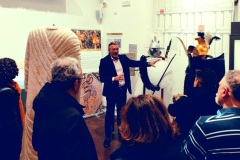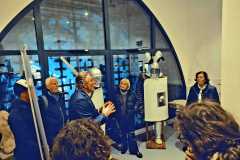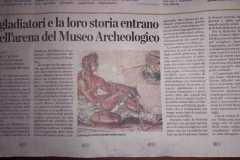Opening of the exhibition at the Archaeological Museum of Bergamo
Brilliant opening of the exhibition on gladiators at the Archaeological Museum of Bergamo in the upper town (Città Alta), curated by Ars Dimicandi. Despite the choice of Tuesday afternoon at 17.00, dozens of people showed up at the start of this impressive presentation.
The Director of the Museum, Dr.ssa Stefania Casini, welcomed the guest and introduced the exhibition. Mrs.Casini located the position location of the Museum probably above the archaeological location of the amphitheater, set in the buildings of Piazza della Cittadella.
The President of Ars Dimicandi, Dario Battaglia, led the visitors into the world of gladiator’s “munera”, sting weapons, reason behind gladiators’ nakedness and why gladiators had to be injured and lose blood in funeral a contexts. A very long history, which begins from the Mycenaean period and crosses the centuries through the Campania-Lucan and the Etruscans, up to the extraordinary juridical and sacred evolution in Rome and in its empire.
A small but fascinating lesson of history that, as Ars Dimicandi has done for 30 years now, dismantles the stereotypes of the Cinema and reconstructs with a wealth of sources the authentic function of gladiature. This introduction was followed by a guided tour of the three stations of the exhibition, for a total of six armor and four explanatory panels accompanied by reproductions of frescoes and mosaics, which Dr.ssa Casini linked to the original finds of the Museum: a gladiator statue, an inscription with the testimony of two other gladiators and some precious elements of the amphitheater of Bergamo.
The opening of the exhibition at the Archaeological Museum of Bergamo ended with duels that delighted (and impressed) the public, amazed by the balance between the contenders and the realism of the fighting. First of all the powerful Provocatores, such as Scaurus (Marco Insalaco from Milan) and Ario (Andrea Pederzini from Modena); to close with the sinuous and syncopated duel between the Thraex B Crannicus (Federico Prandini from Modena) and the Hoplomachus Theros (Roberto Prandini from Modena).
Applause and request to replicate the guided tours and duels for the day of Epiphany, January 6, also inviting children who will be home for the holidays.



